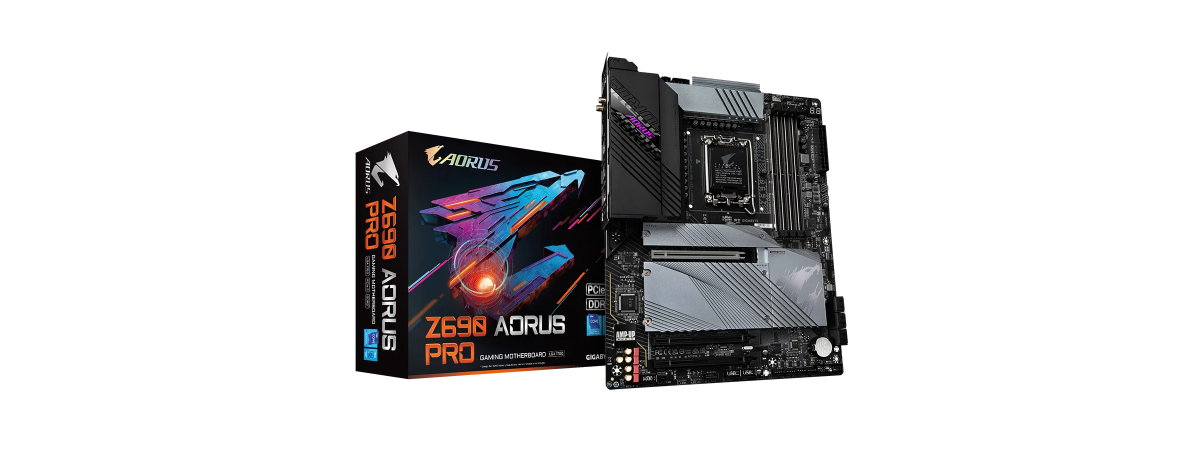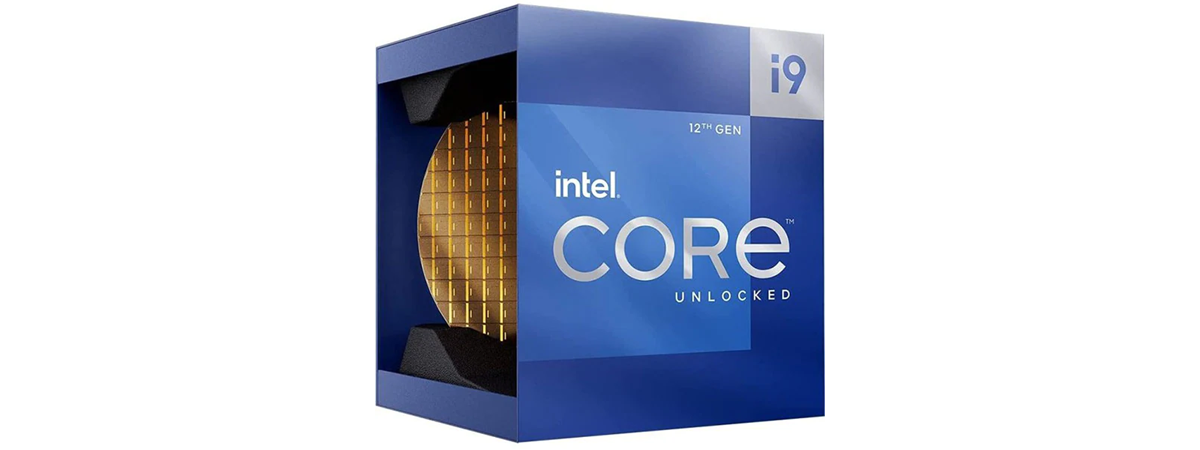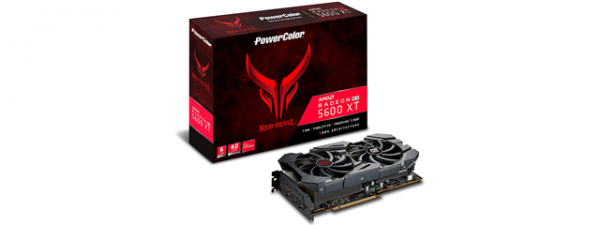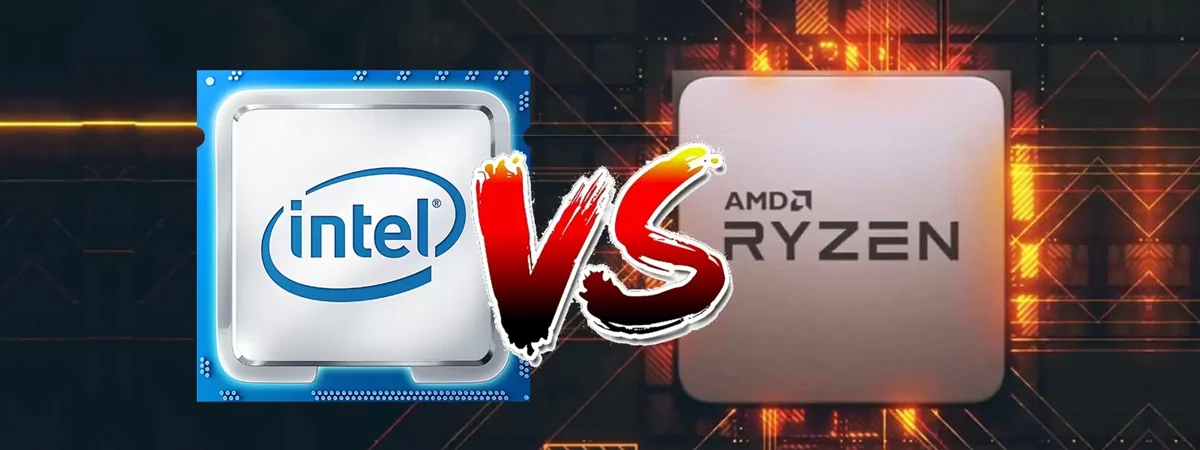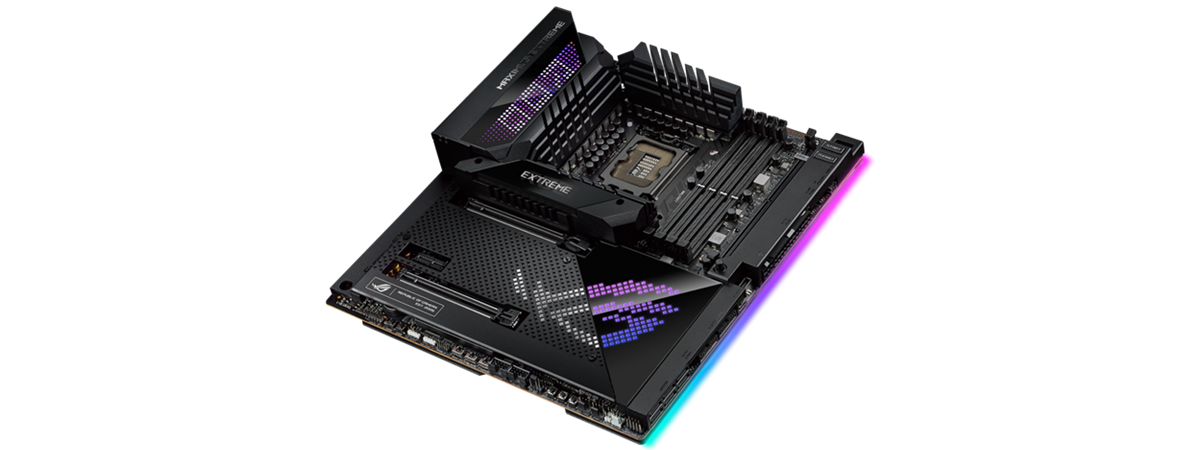
ASUS ROG Maximus Z690 Extreme - Testing setup
As you know now, the ROG Maximus Z690 Extreme is ASUS’ top-of-the-line premium motherboard for Intel Alder Lake processors. This mainboard is what you could call the pinnacle of ASUS’ Z690 motherboards, which the company presented on YouTube on October 27th. The Maximus Z690 Extreme, together with the other Republic of Gamers mainboards based on the Z690 chipset, like the Extreme Glacial or Apex, all come with top-notch power supply specially designed for Alder Lake processors, support for XMP 3 and built-in ASUS enhanced memory profiles, Wi-Fi 6E and Thunderbolt 4, and PCI Express 5.0.

ASUS motherboards for Intel Alder Lake processors
To match all the features and performance offered by such a motherboard, we had to run our tests using only premium hardware components. For this review of the ASUS ROG Maximus Z690 Extreme motherboard, we chose the following hardware and software:
- Processor: Intel Core i7-12700K
- Cooler: ASUS ROG Ryujin II 360
- Memory: Kingston FURY Beast DDR5 RAM (2 x 16GB, 4800MHz)
- Graphics Card: ASUS TUF Gaming GeForce RTX 3090
- Storage: Kingston KC3000 SSD (2TB, PCI-Express 4.0)
- Monitor: ASUS ROG Strix XG32VQ Curved Gaming Monitor (2560 x 1440 resolution, at 144Hz)
- Power Supply Unit: ASUS ROG Thor 850W Platinum
- Operating System: Windows 11 Pro Version 21H2 Build 22000.348
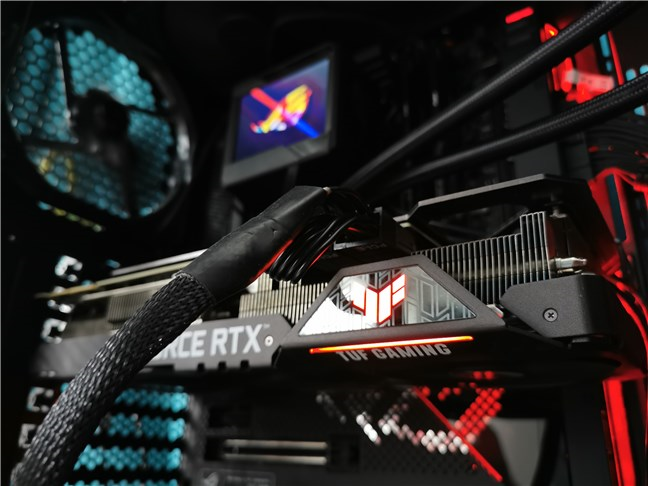
ASUS TUF Gaming GeForce RTX 3090
Additionally, we also compared the test results with those we got using the same processor and hardware components on a Gigabyte AORUS Z690 Pro motherboard. Let’s see what the benchmarks had to say about the ASUS ROG Maximus Z690 Extreme:
ASUS ROG Maximus Z690 Extreme - Benchmark results
We started by running the benchmark offered by CPU-Z. In the Single Thread test, using the ASUS ROG Maximus Z690 Extreme motherboard, the Intel Core i7-12700K processor scored 792 points, almost identical to what we got on the Gigabyte AORUS Z690 Pro mainboard.
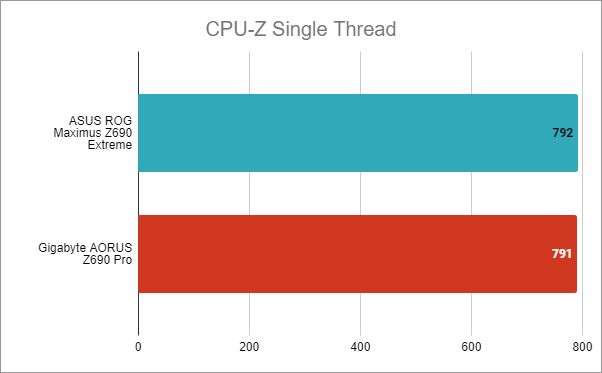
ASUS ROG Maximus Z690 Extreme: Benchmarks in CPU-Z Single-Thread
In CPU-Z's Multi Thread test, which measures the multi-core performance of the processor, Intel Core i7-12700K got 9299 points on the ASUS ROG Maximus Z690 Extreme, and 9300 points on the Gigabyte AORUS Z690 Pro, again almost identical results.
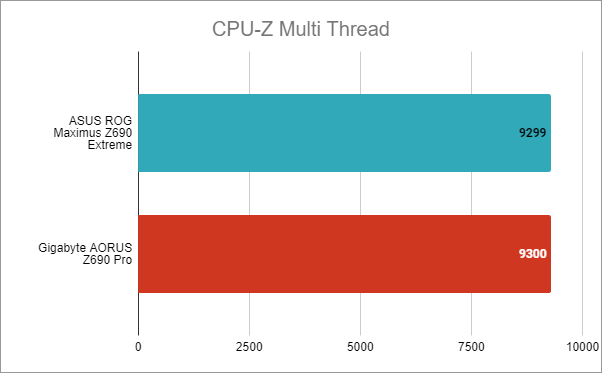
ASUS ROG Maximus Z690 Extreme: Benchmarks in CPU-Z Multi-Thread
Then we ran Cinebench R23, a benchmark that measures the computer’s rendering speed. With ASUS ROG Maximus Z690 Extreme we got 22128 points, which is very slightly better than when we used the Gigabyte AORUS Z690 Pro, on which we measured 22032 points.
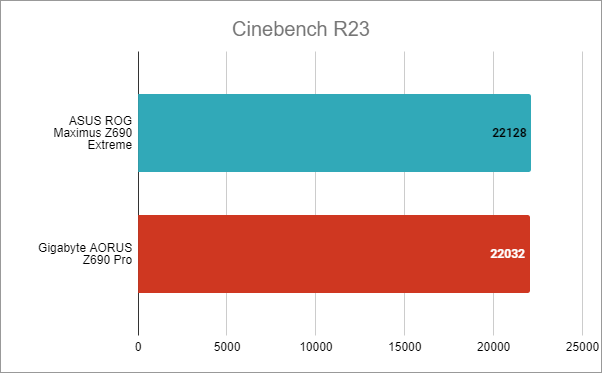
ASUS ROG Maximus Z690 Extreme: Benchmarks in Cinebench R23
In Blender, we measured the time needed by the computer to render two different scenes (bmw27 and classroom). The Intel Core i7-12700K CPU on the ASUS ROG Maximus Z690 Extreme motherboard finished in 6.9 minutes, while on the Gigabyte AORUS Z690 Pro it needed 6.8 minutes. Here, it looks like ASUS’ motherboard performed a bit slower, but the results are in the testing process margin of error.
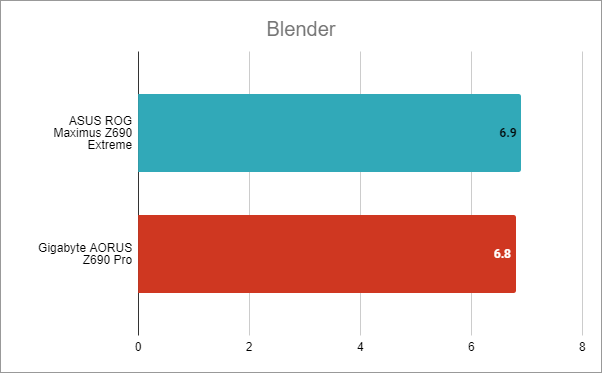
ASUS ROG Maximus Z690 Extreme: Benchmarks in Blender
Next, we ran PCMark 10, a benchmark that aims to measure the computer’s performance in regular activities such as web browsing, video conferencing, app start-up times, productivity, and digital content creation. Using the ASUS ROG Maximus Z690 Extreme motherboard, we got 8517 points, and 8528 points with the Gigabyte AORUS Z690 Pro. Yet again, the results are very similar, well within the margin of error for this sort of benchmark.
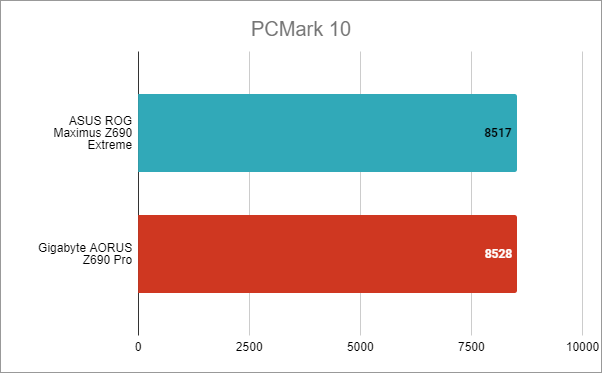
ASUS ROG Maximus Z690 Extreme: Benchmarks in PCMark 10
Web browsing is one of the most common activities for anyone using a computer, so the speed of loading websites is essential for us all. To assess the performance of our test computer on the internet, we used JetStream 2 in Google Chrome. As you can see in the next chart, we were in for a surprise when we found that the ASUS ROG Maximus Z690 Extreme got a slightly weaker result (6% less) than the Gigabyte AORUS Z690 Pro.
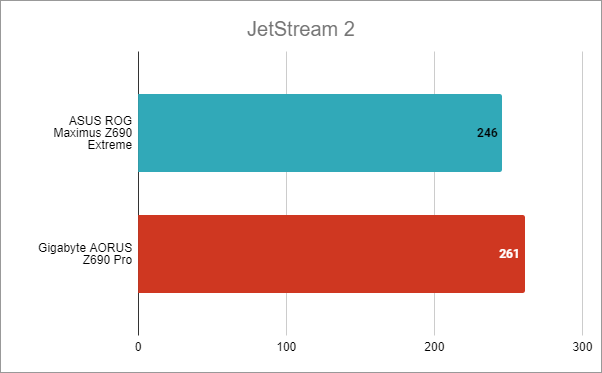
ASUS ROG Maximus Z690 Extreme: Benchmarks in JetStream 2
We also tested a few games, starting with Shadow of the Tomb Raider, which showed that the processor, using any of the two motherboards, could render more than 200 frames per second. We ran the benchmark using 1080p resolution and the lowest graphics quality, to show only what the processor can do on these mainboards.
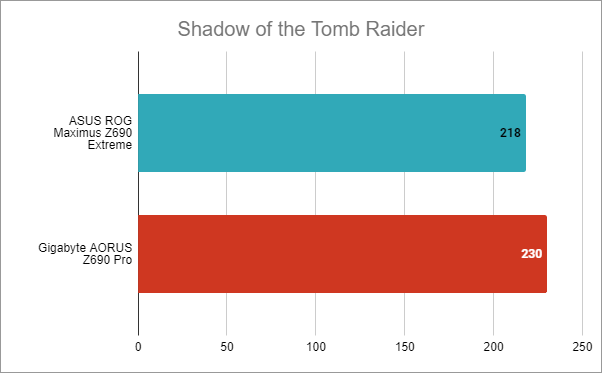
ASUS ROG Maximus Z690 Extreme: Benchmarks in Shadow of the Tomb Raider
In Metro Exodus, a very resource-hungry game, using the lowest visuals possible, we again saw an average frame rate of more than 200.
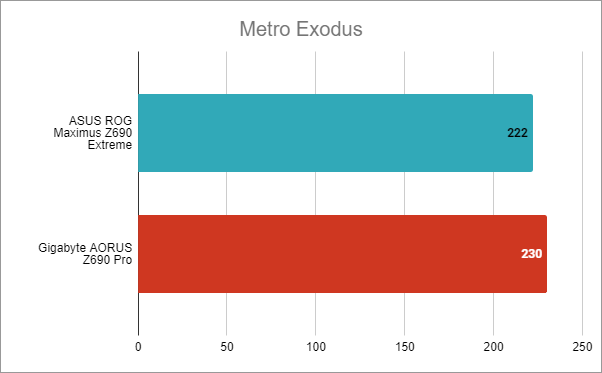
ASUS ROG Maximus Z690 Extreme: Benchmarks in Metro Exodus
In Assassin’s Creed Valhalla, on the lowest graphics quality and in 1080 resolution, we measured an average frame rate of 166 when using the ASUS ROG Maximus Z690 Extreme motherboard, and 168 fps when using the Gigabyte AORUS Z690 Pro.
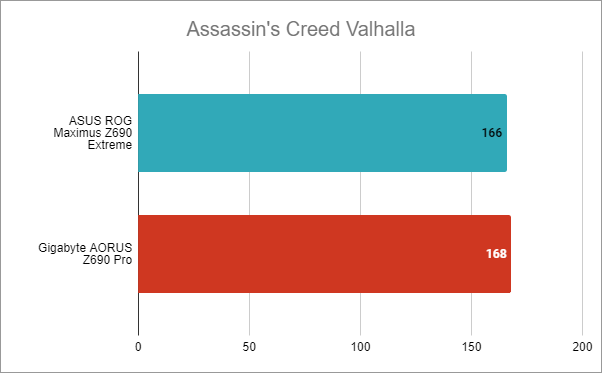
ASUS ROG Maximus Z690 Extreme: Benchmarks in Assassin’s Creed Valhalla
Although the test results depend a lot on what processor, RAM, or storage devices you use, benchmarking a motherboard can give us an insight on what to expect from it. And, as you’ve seen, the ASUS ROG Maximus Z690 Extreme is able to deliver excellent results in any kind of situation.
Software bundled with the ASUS ROG Maximus Z690 Extreme
We’ll start by saying something quite unexpected: you don’t get any bloatware from ASUS! Practically, you can just install the motherboard, and clean install Windows 11 or Windows 10 for that matter, and use none of the software offered by ASUS. Everything is as clean as it gets. However, if you want to, and we recommend you do so, after you install the operating system, you’ll be asked whether you want to download and install ASUS’ Armoury Crate app.
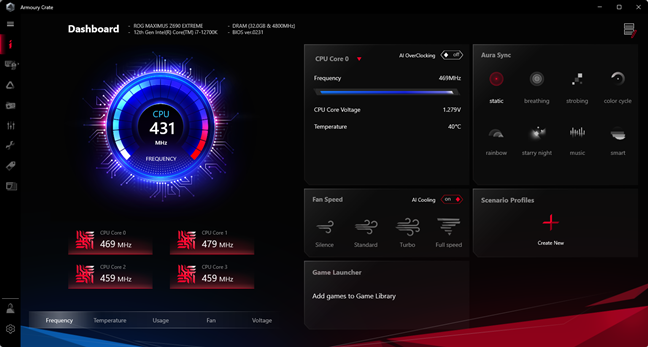
Armoury Crate: A hub for drivers, tools, and settings
Why should you use it? Well, because this app is essential for getting access to all the personalization options and features of the ROG Maximus Z690 Extreme motherboard. Besides giving you an overall view and monitoring tools of your hardware, Armoury Crate lets you control the fans in your computer, it helps you install the motherboard drivers automatically, update BIOS, adjust the Aura Sync RGB lighting effects, and change settings for your other Republic of Gamers devices.
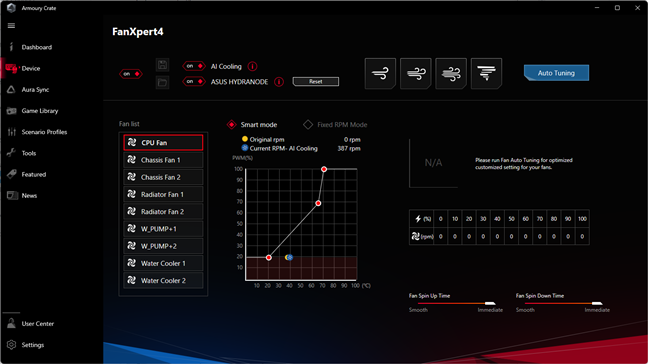
Settings for the fans in your computer
Furthermore, in this particular case, when you own an ASUS ROG Maximus Z690 Extreme motherboard, the Armoury Crate is needed if you want to customize the AniMe Matrix LED plate, as well as the OLED display under the CPU.
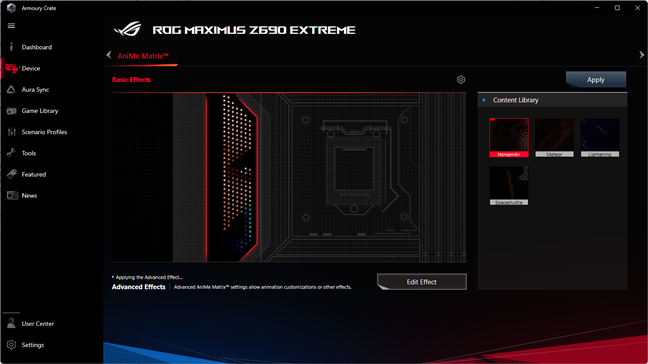
AniMe Matrix settings available in Armoury crate
There are other optional utility apps that ASUS offers with the ASUS ROG Maximus Z690 Extreme motherboard, but, as we’ve said, you don’t have to install them unless you want. Using Armoury Crate, you can add the following tools on your computer:
- Google Chrome: the most widely used web browser in the world, so no further explanations are required.
- AI Suite 3: a desktop program that analyzes your system and shows you information about it, while also helping you optimize things such as power consumption or the speed of the fans.
- AIDA64 Extreme: a system reporting and benchmarking tool that can be really useful if you want in-depth details about your computer, or want to test its performance and stability
- BullGuard Internet Security: a security solution that includes a good antivirus and firewall, and for which, in theory, you get a one-year subscription. However, when we installed it, we only got 30 days of trial.
- CPUID ROG CPU-Z: a small tool that shows you information about your processor and also lets you quickly benchmark it.
- GameFirst VI: a tool made by ASUS that helps you optimize the network traffic in order to have a lag-free gaming experience.
- WinRAR: a popular shareware compression tool.
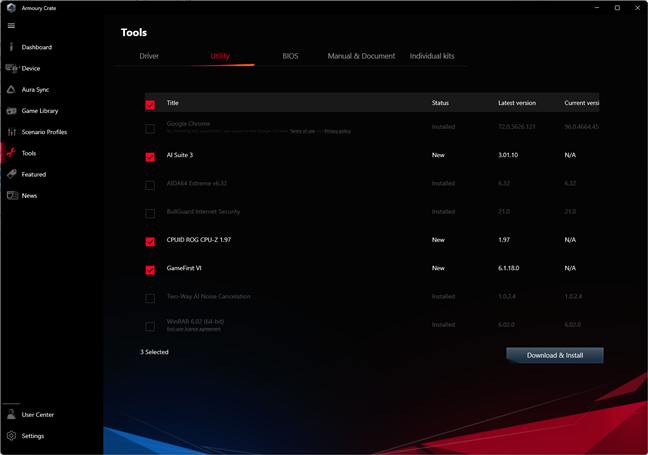
Additional tools that you can install
The Armoury Crate app available for the ASUS ROG Maximus Z690 Extreme is useful and works great. You need it if you want to personalize the way your motherboard looks and works, so you should install it. As for the additional apps that you can install, it’s your choice, and we appreciate that ASUS doesn’t force you to use them.
What’s your opinion about the ASUS ROG Maximus Z690 Extreme?
At the end of this review, it’s pretty obvious that we like the ASUS ROG Maximus Z690 Extreme motherboard a lot. Before leaving, tell us your opinion about it. Do you own it, or do you have the (very generous) budget to buy it? Are you impressed by its numerous features? Let us know what you think in the comments section below.


 08.12.2021
08.12.2021 